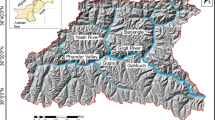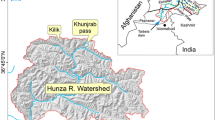Abstract
A preliminary landslide inventory map has been prepared for the Shyok River watershed in northern Pakistan. The document is intended for use as a screening tool in route selection of engineered infrastructure of this mountainous area preparatory to undertaking site-specific investigations of possible landslides that could adversely impact such routes. Remote sensing techniques and GIS software can be utilized to prepare a reconnaissance-level landslide inventory and gross susceptibility maps at relatively low cost. This watershed was selected as a test location for regional landslide inventory mapping because of the high density of deep-seated bedrock landslides. Topographic recognition keys were employed on a stitched shaded topographic map of the study area using 40-m contour topographic maps and 30-m resolution ASTER DEM data. The goal of these efforts is to delineate slopes with anomalous topography, often indicative of past land slippage. Most of the landslide features are expressive of composite and complex landslides, extending into the parent bedrock units. The results of this mapping were then compared with historic data and regional level landslide susceptibility maps. This effort is intended to serve as a reconnaissance-level inventory map to provide qualitative, first-order information about the probable existence of bedrock landslides and related mass wasting features, which are subject to field verification.











Similar content being viewed by others
References
Ahmad I, Jan MQ and Dipietro A. (2003) Age and tectonic implications of granitoid rocks from the Indian Plate of northern Pakistan in Singh S, (ed.), Granitoids of the Himalayan collisional belt: Journal of the Virtual Explorer 11: paper 01
Ahmed MF, Rogers JD (2014) Creating reliable, first-approximation landslide inventory maps, using ASTER DEM data and geomorphic indicators, an example from the upper Indus River in northern Pakistan. Environ Eng Geosci 20(1):67–83
Ahmed MF, Rogers JD, Ismail EH (2014) A regional level preliminary landslide hazard study of upper Indus River basin. Eur J Rem Sens 47:343–373
Ahmed MF, Rogers JD, Ismail HE (2015) Historic Landslide Dams along the Upper Indus River, Northern Pakistan. Nat Hazards Rev 16(3). doi:10.1061/(ASCE)NH.1527-6996.0000165
Balteanu D, Chendeş V, Sima M, Enciu P (2010) A country-wide spatial assessment of landslide susceptibility in Romania. Geomorphology 124:102–112
Brabb EE (1991) The world landslide problem. Episodes 14(1):52–61
Cardinali M, Guzzetti F, Brabb EE (1990) Preliminary map showing landslide deposits and related features in New Mexico. US Geological Survey Open File Report 90/293, 4 sheets, scale 1:500,000
Carrara M, Cardinali M, Guzzetti F (1991) Uncertainty in assessing landslide hazard and risk. ITC J 2:172–183
Cockerill GK (1902) Byways of Hunza and Nagar. Geogr J 60:98–112
Crosta GB (2001) Failure and flow development of a complex slide: the 1993 Sesa landslide. Eng Geol 59:173–199
Crozier MJ (2010) Landslide geomorphology: An argument for recognition, with examples from New Zealand. Geomorphology 120:3–15
Cruden DM, Varnes DJ (1996) Landslide types and processes. In: Turner AK, Schuster RL (eds) Landslides, investigation and mitigation, special report 247. Transportation Research Board, Washington, pp 36–75
Dikau R, Brunsden D, Schrott L, and Ibsen ML (Eds.) (1996) Landslide Recognition Identification, Movement and Causes. Wiley, Chichester
Doyle BC, Rogers JD (2005) Seismically-induced lateral spread features in the Western New Madrid Seismic zone. Env Eng Geosci XI(3):251–258
Goudie AS, Brunsden D, Collins DN, Derbyshire E, Fergu-son, RI, Hashnet Z, Jones DKC, Perrott FA, Said M,Waters RS, Whalley WB (1984) The geomorphology of the Hunza Valley, Karakoram Mountains, Pakistan. In: MillerK Ed. International Karakoram Project. Cambridge Univ. Press Cambridge pp. 33–411
Glade T (2001) Landslide hazard assessment and historical landslide data: an inseparable couple? In: Glade T, Albini P & F Frances (Hrsg.): the use of historical data in natural hazard assessments: Springer, Berlin. pp 153–167
Guzzetti F, Carrara A, Cardinali M, Reichenbach P (1999) Landslide hazard evaluation: a review of current techniques and their application in a multi-scale study, Central Italy. Geomorphology 31:181–216
Guzzetti F, Reichenbach P, Ardizzone F, Cardinali M, Galli M (2006) Estimating the quality of landslide susceptibility models. Geomorphology 81:166–184
Hansen A (1984) Landslide hazard analysis. In: Slope instability, edited by: Brunsden, D, Prior DB. Wiley, New York. pp 523–602
Hart MW, Shaller JP, Farrand G (2012) When landslides are misinterpreted as faults: case studies from the Western United States. Env Eng Geosc XVIII(4):313–325
Hewitt K (1982) Natural dams and outburst floods of the Karakoram Himalaya, in Glen J ed. Hydrological aspects of Alpine and High Mountain areas. International Hydrological Association Publication 138:259–269
Hewitt K (1998) Catastrophic landslides and their effects on the Upper Indus streams, Karakoram Himalaya, northern Pakistan. Geomorphology 26:47–80
Hewitt K (2002) Styles of rock-avalanche depositional complexes conditioned by very rugged terrain, Karakoram Himalaya Pakistan in Evans SG, Degraff JV, eds. Catastrophic landslides: effects, occurrence, and mechanisms. Boulder, Colorado, Geological Society of America, Reviews in Engineering Geology XV:345–377
Hewitt K, Gosse J, Clague JJ (2011) Rock avalanches and the pace of late Quaternary development of river valleys in the Karakoram Himalaya. Geol Soc Am Bull 123(9/10):1836–1850
Hsiegh ML, Lai LSH, Lin CDJ, Shyu JBH (2012) Late Quaternary landscape evolution and genesis of the 2009 catastrophic landslide in the Hsiao-lin area, southwestern Taiwan. Geomorphology 179:225–239
Hutchinson JN (1968) Mass Movement. In: Fairbridge RW (ed) The encyclopedia of geomorphology. Reinhold Book Corp, New York, pp 688–696
Kazmi AH, Jan MQ (1997) Geology and tectonics of Pakistan, Graphic Publishers, p 554. ISBN: 9698375007
Keefer DK (1984) Landslides caused by earthquakes. Geol Soc Am Bull 95:406–421
Korup O, Montgomery DR, Hewitt K (2010) Glacier and landslide feedbacks to topographic relief in the Himalayan syntaxes. Proc Natl Acad Sci USA 107(12):5317–5322
Mason K (1914) The Indo-Russian triangulation connection, 1911–1913. Geogr J 43:664–672
McCalpin J (1984) Preliminary age classification of landslides for inventory mapping: Proceedings 21st annual engineering geology and soils engineering symposium. University Press, Moscow, pp 99–111
Negi SS (1991) Himalayan rivers, lakes, and glaciers. Indus Publishing Company New Delhi, p 182
Pike RJ (1988) The geometric signature: quantifying landslide-terrain types from digital elevation models. Math Geol 20(5):491–511
Rib HT, Liang T (1978) Recognition and identification, In: Schuster, RL, Krizek RJ (eds.), Landslide Analysis and Control. Transportation Research Board Special Report No. 176, National Academy Sciences, Washington, pp 34–80
Rogers JD (1980) Factors affecting hillslope profile: current topics in geomorphology, Berkeley UC, unpublished manuscript. UC Water Resources Center Archives Riverside CA, p 67
Rogers J, David (1998) Topographic expression of deep-seated bedrock landslide complexes. Notes accompanying evaluation and mitigation of seismic hazards, University of California Extension, Los Angeles, p 13
Rogers/Pacific Inc. (1994) Report Accompanying Map of Landslides and Other Surficial Deposits of the City of Orinda, CA. Consultant’s report for the City of Orinda Public Works Department, p 141
Rogers JD, Ahmed, MF (2013) Discussion of risk factors for triggering of rockslide avalanche dams in Pakistan, Afghanistan, and Tajikistan and mitigation strategies. In: Proceedings 47th US Rock Mechanics/Geomechanics Symposium, American Rock Mechanics Association, Paper 13–591, San Francisco CA
Searle MP (1991) Geology and tectonics of the Karakoram Mountains. New York, John Wiley 5:231–236
Shroder JF Jr, Bishop MP (1998) Mass movement in the Himalaya: new insights and research directions. Geomorphology 26:13–35
Tachikawa T, Kaku MA, Iwasaki A (2009) ASTER GDEM validation. Presentation at the 35th ASTER Science Team Meeting, Kyoto, Japan
Tachikawa T, Kaku M, Iwasaki A, Gesch D. Oimoen M, Zhang Z, Danielson J, Krieger T, Curtis B, Haase J, Abrams M, Crippen R, and Carabajal C (2011) ASTER Global Digital Elevation Model Version 2-Summary of Validation Results. Report to the ASTER GDEM Validation Team, Tokyo, Japan, pp 15–24
Terzaghi K (1950) Mechanism of Landslides. In: Paige S, Ed. application of geology to engineering practice (Berkey Volume). The Geological Society of America, pp 83–123
Van Den Eeckhaut M, Moeyersons J, Nyssen J, Abraha A, Poesen J, Haile M, Deckers J (2009) Spatial patterns of old, deep-seated landslides: a case-study in the northern Ethiopian highlands. Geomorphology 105:239–252
Van Den Eeckhaut M, Poesen J, Gullentops F, Vandekerckhove L, Hervas J (2011) Regional mapping and characterization of old landslides in hilly regions using LiDAR-based imagery in Southern Flanders. Quatern Res 75:721–733
Varnes DJ (1978) Slope movement types and processes, in Schuster RL, and Krizek RJ, eds Landslides: Analysis and control. National Research Council, Washington, DC, Transportation Research Board, National Academy Press, Special Report 176:11–33
Varnes DJ (1984) Landslide hazard zonation: a review of principles and practice. Commission of Landslides of the IAEG UNESCO, Natural Hazards No. 3, p 61
Whittow J (1984) Dictionary of physical geography. London: Penguin, p 275
WP/WLI (International Geotechnical Societies UNESCO Working Party for World Landslide Inventory) (1993) The Multilingual Landslide Glossary. Bi-Tech Publishers, Richmond, British Columbia Canada, p 59
Acknowledgments
The authors are thankful to the Natural Hazards Mitigation Institute at the Missouri University of Science and Technology, Rolla, MO, USA, for their support of this study. This research was funded by a scholarship grant from the University of Engineering and Technology, Lahore, Pakistan.
Author information
Authors and Affiliations
Corresponding author
Additional information
M. F. Ahmed: on leave from the University of Engineering and Technology Lahore, Pakistan.
Rights and permissions
About this article
Cite this article
Farooq Ahmed, M., David Rogers, J. Regional level landslide inventory maps of the Shyok River watershed, Northern Pakistan. Bull Eng Geol Environ 75, 563–574 (2016). https://doi.org/10.1007/s10064-015-0773-2
Received:
Accepted:
Published:
Issue Date:
DOI: https://doi.org/10.1007/s10064-015-0773-2




